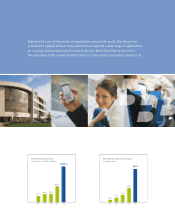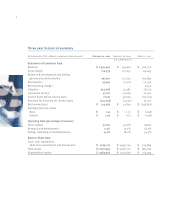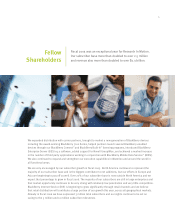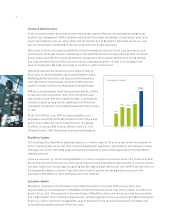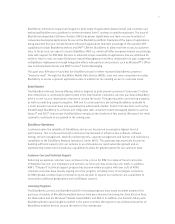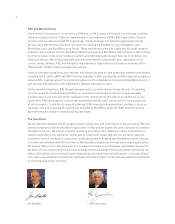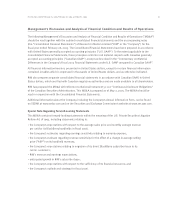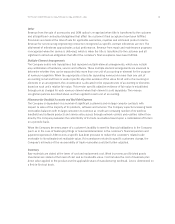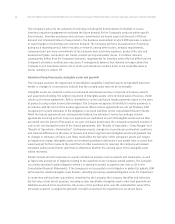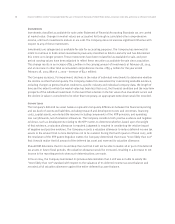Blackberry 2005 Annual Report Download - page 15
Download and view the complete annual report
Please find page 15 of the 2005 Blackberry annual report below. You can navigate through the pages in the report by either clicking on the pages listed below, or by using the keyword search tool below to find specific information within the annual report.
13
Other
Revenue from the sale of accessories and OEM radios is recognized when title is transferred to the customer
and all significant contractual obligations that affect the customer’s final acceptance have been fulfilled.
Provisions are made at the time of sale for applicable warranties, royalties and estimated product returns.
Revenue for non-recurring engineering contracts is recognized as specific contract milestones are met. The
attainment of milestones approximates actual performance. Revenue from repair and maintenance programs
is recognized when the service is delivered, which is when the title is transferred to the customer and all
significant contractual obligations that affect the customer’s final acceptance have been fulfilled.
Multiple-Element Arrangements
The Company enters into transactions that represent multiple-element arrangements, which may include
any combination of hardware, service and software. These multiple-element arrangements are assessed to
determine whether they can be separated into more than one unit of accounting or element for the purpose
of revenue recognition. When the appropriate criteria for separating revenue into more than one unit of
accounting is met and there is vendor specific objective evidence of fair value for all units of accounting or
elements in an arrangement, the consideration is allocated to the separate units of accounting or elements
based on each unit’s relative fair value. This vendor specific objective evidence of fair value is established
through prices charged for each revenue element when that element is sold separately. The revenue
recognition policies described above are then applied to each unit of accounting.
Allowance for Doubtful Accounts and Bad Debt Expense
The Company is dependent on a number of significant customers and on large complex contracts with
respect to sales of the majority of its products, software and services. The Company expects increasing trade
receivables balances with its large customers to continue as it sells an increasing number of its wireless
handheld and software products and service relay access through network carriers and resellers rather than
directly. The Company evaluates the collectibility of its trade receivables based upon a combination of factors
on a periodic basis.
When the Company becomes aware of a customer’s inability to meet its financial obligations to the Company
(such as in the case of bankruptcy filings or material deterioration in the customer’s financial position and
payment experience), RIM records a specific bad debt provision to reduce the customer’s related trade
receivable to its estimated net realizable value. If circumstances related to specific customers change, the
Company’s estimates of the recoverability of trade receivables could be further adjusted.
Inventory
Raw materials are stated at the lower of cost and replacement cost. Work in process and finished goods
inventories are stated at the lower of cost and net realizable value. Cost includes the cost of materials plus
direct labor applied to the product and the applicable share of manufacturing overhead. Cost is determined on
a first-in-first-out basis.
For the years ended February 26, 2005, February 28, 2004 and March 1, 2003


